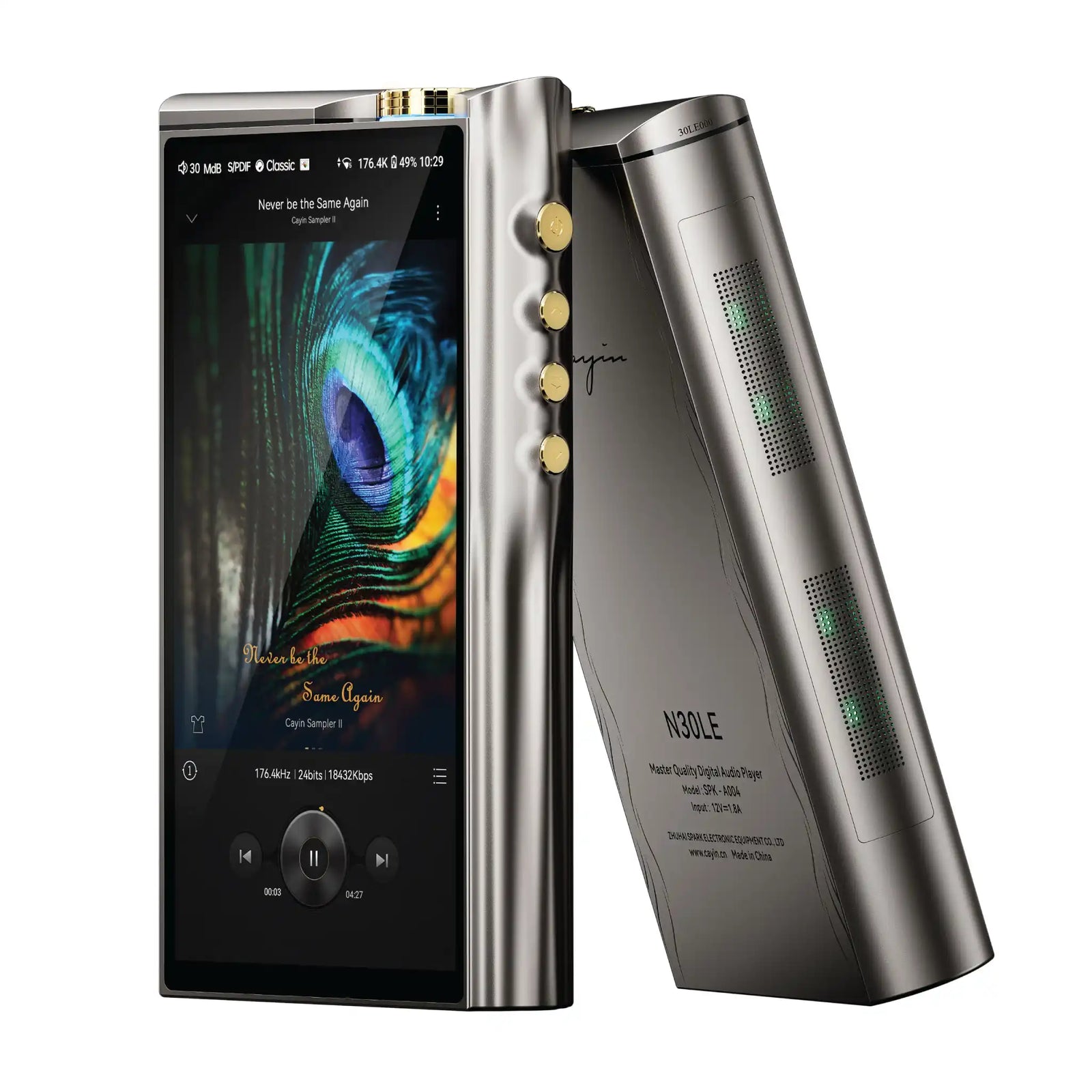
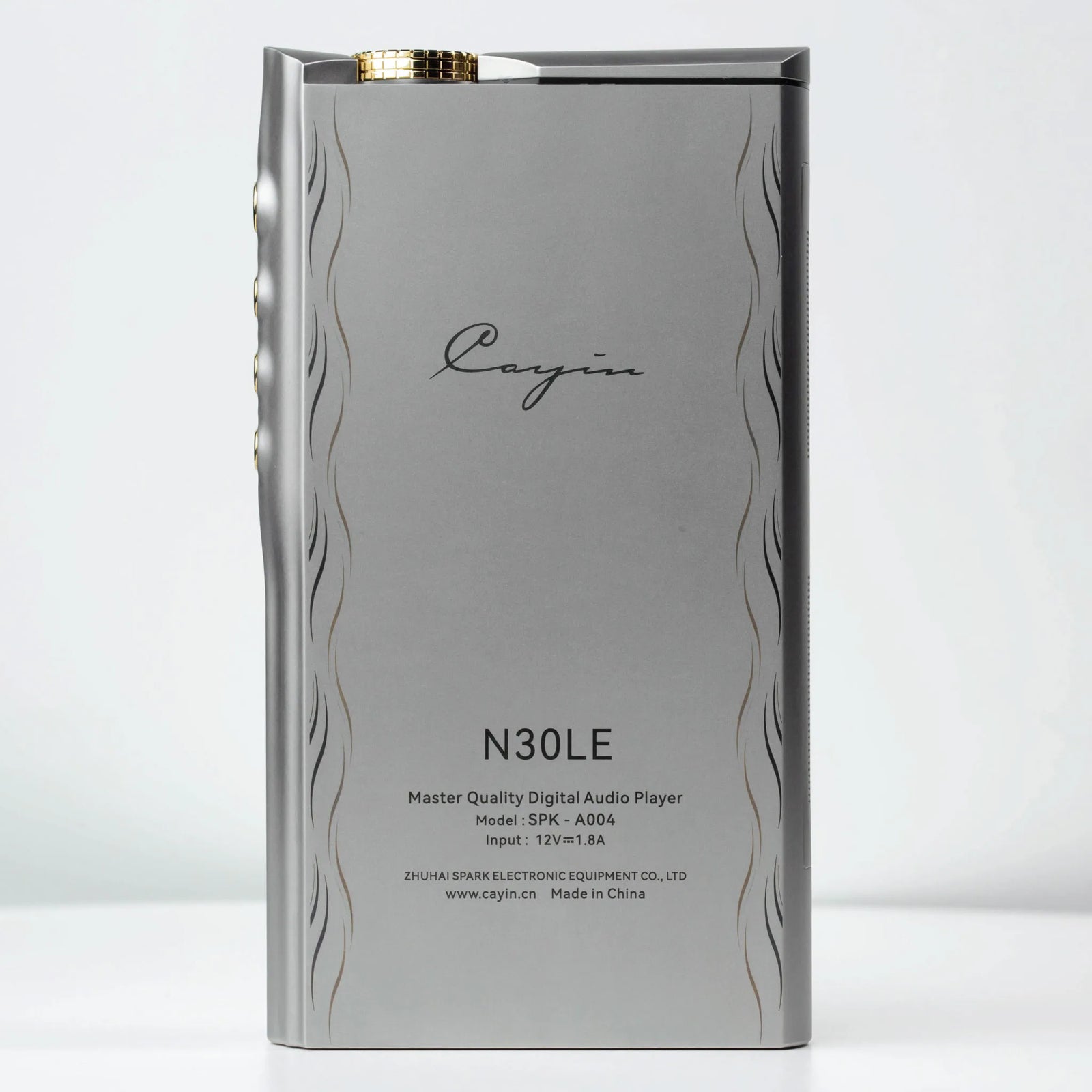
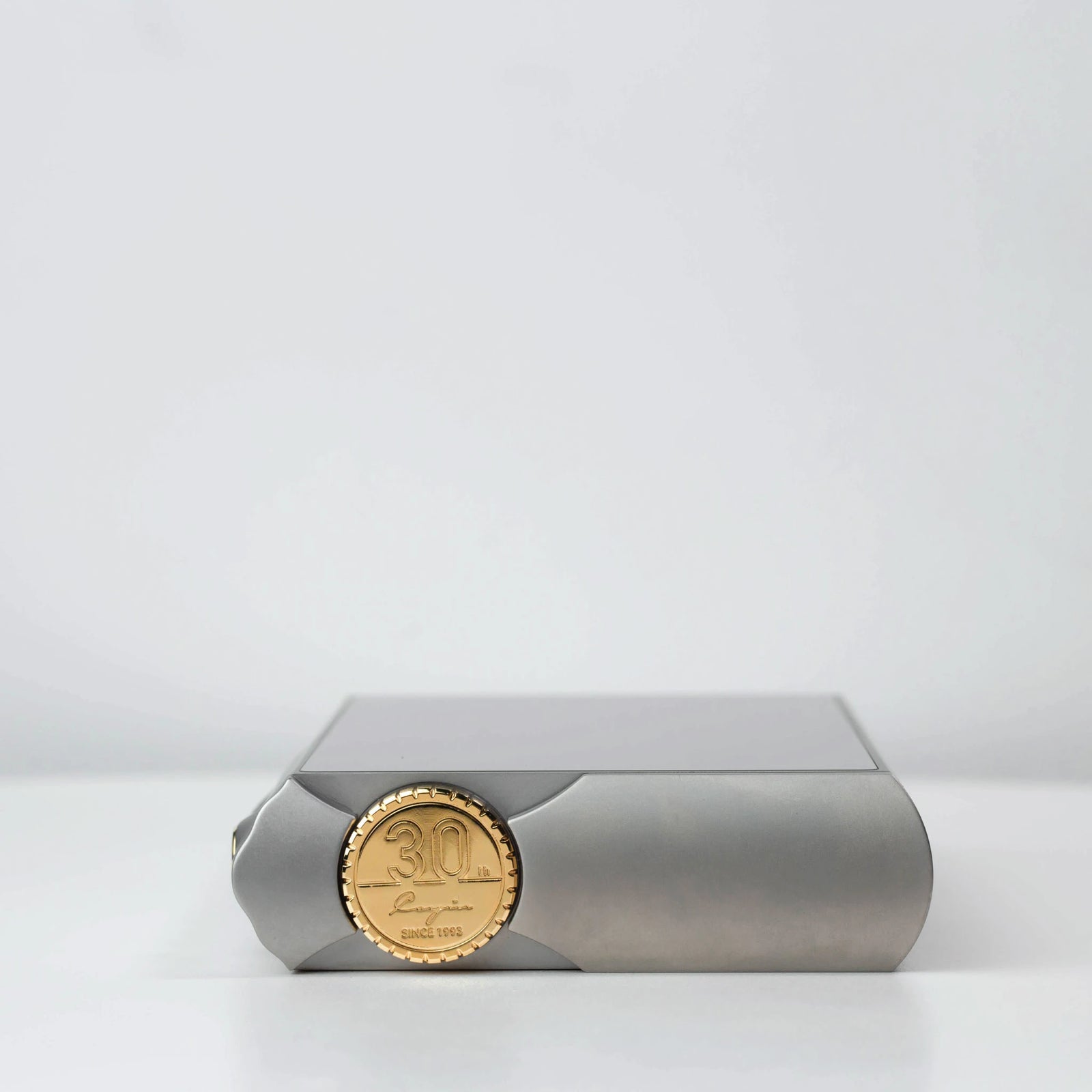
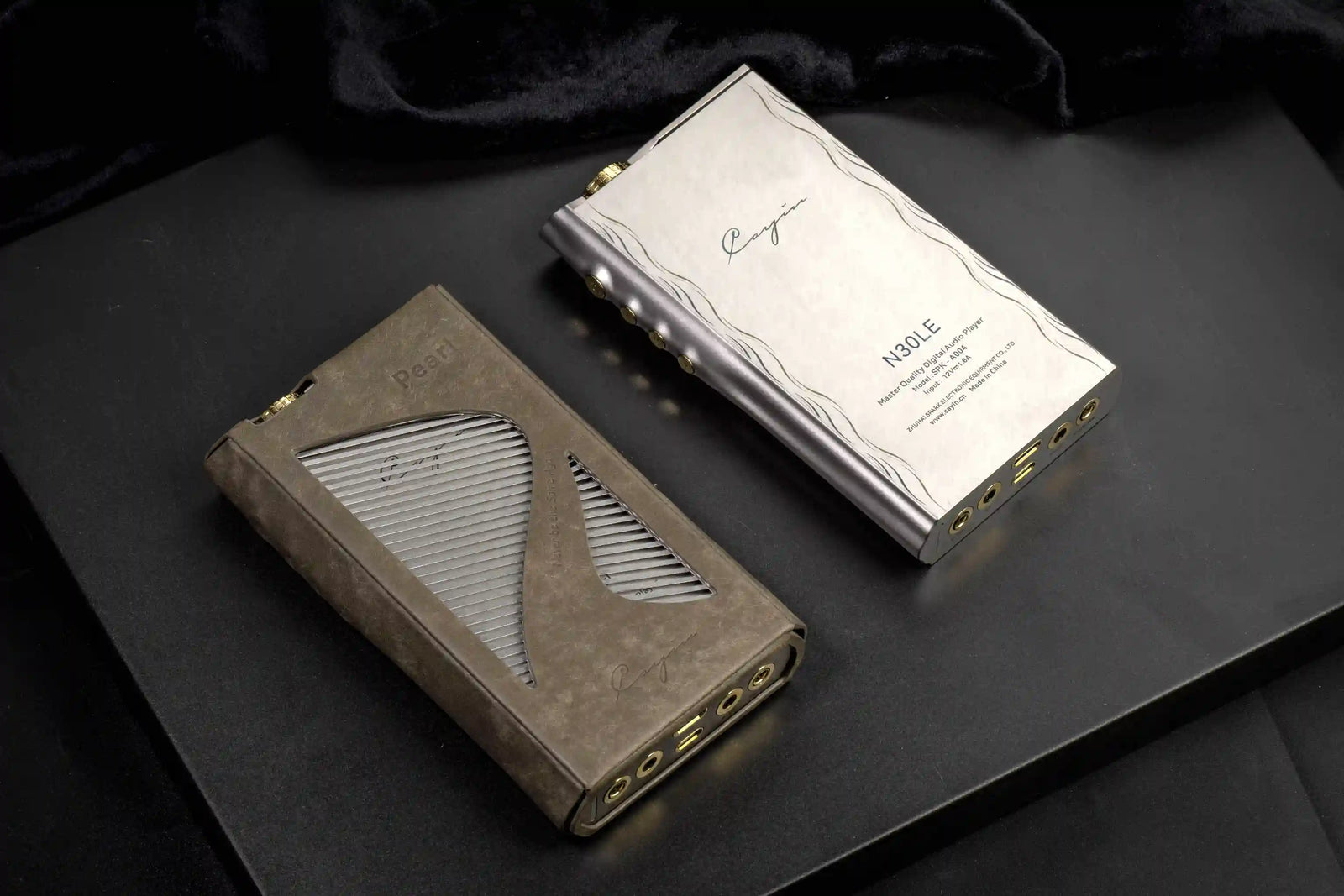
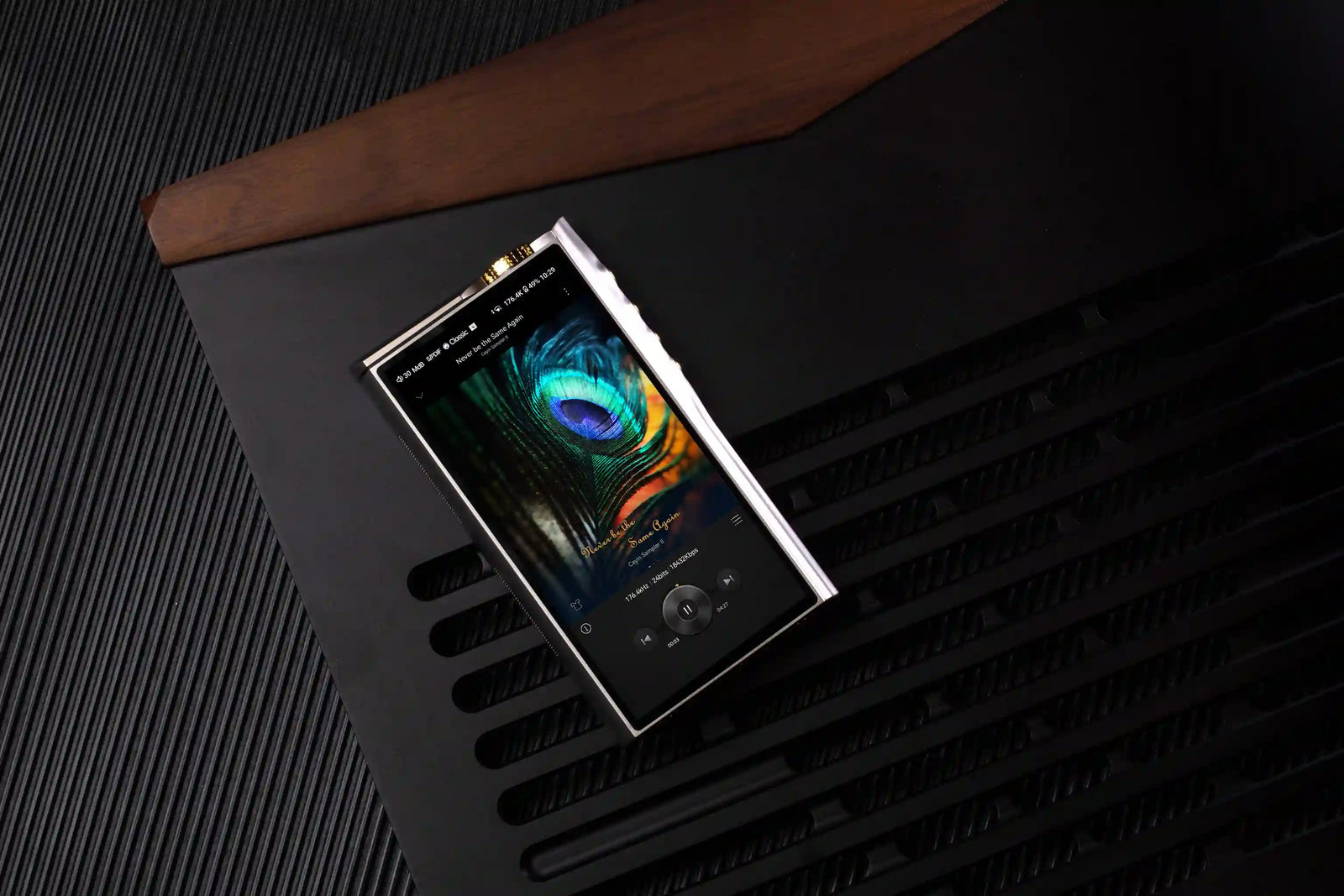
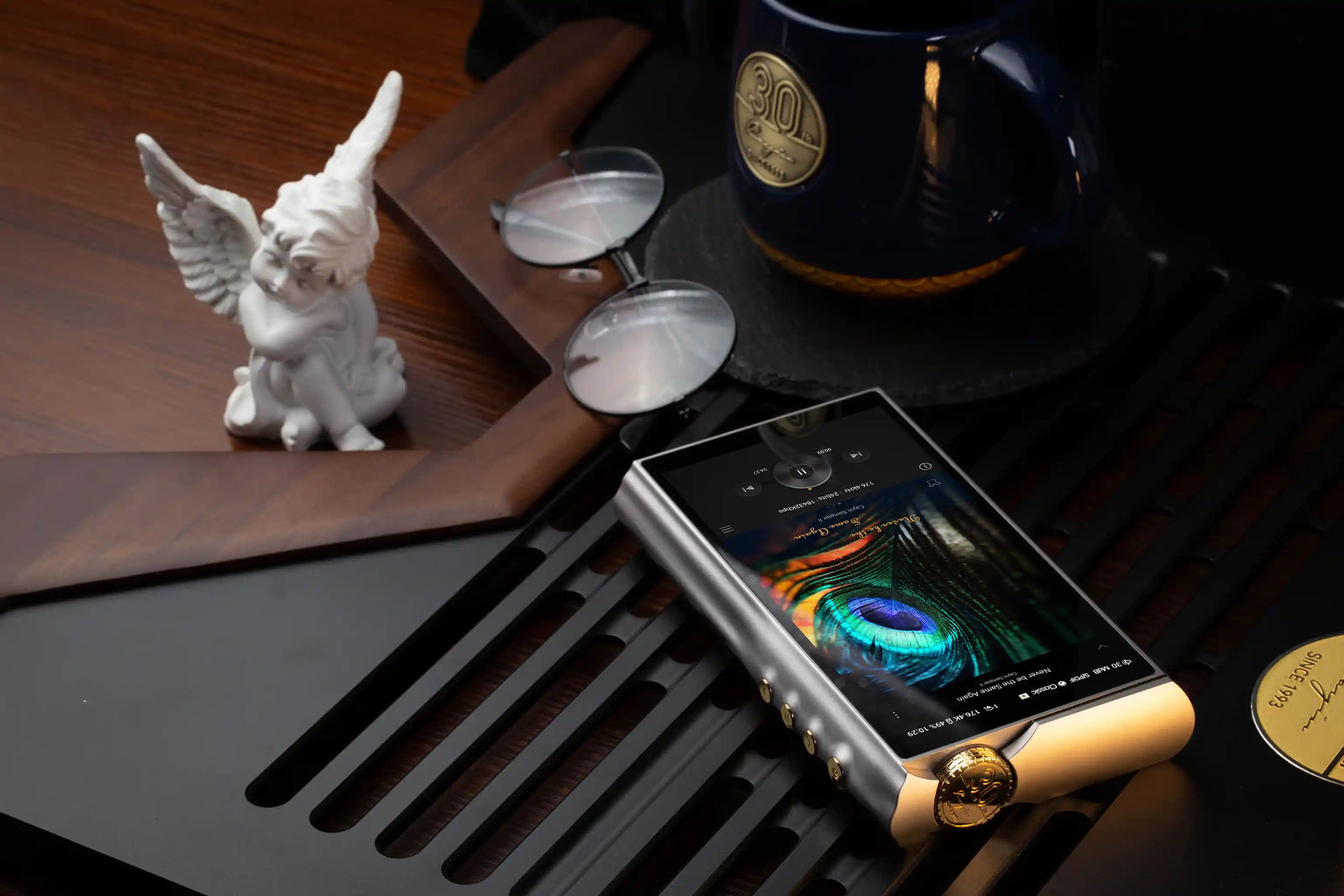
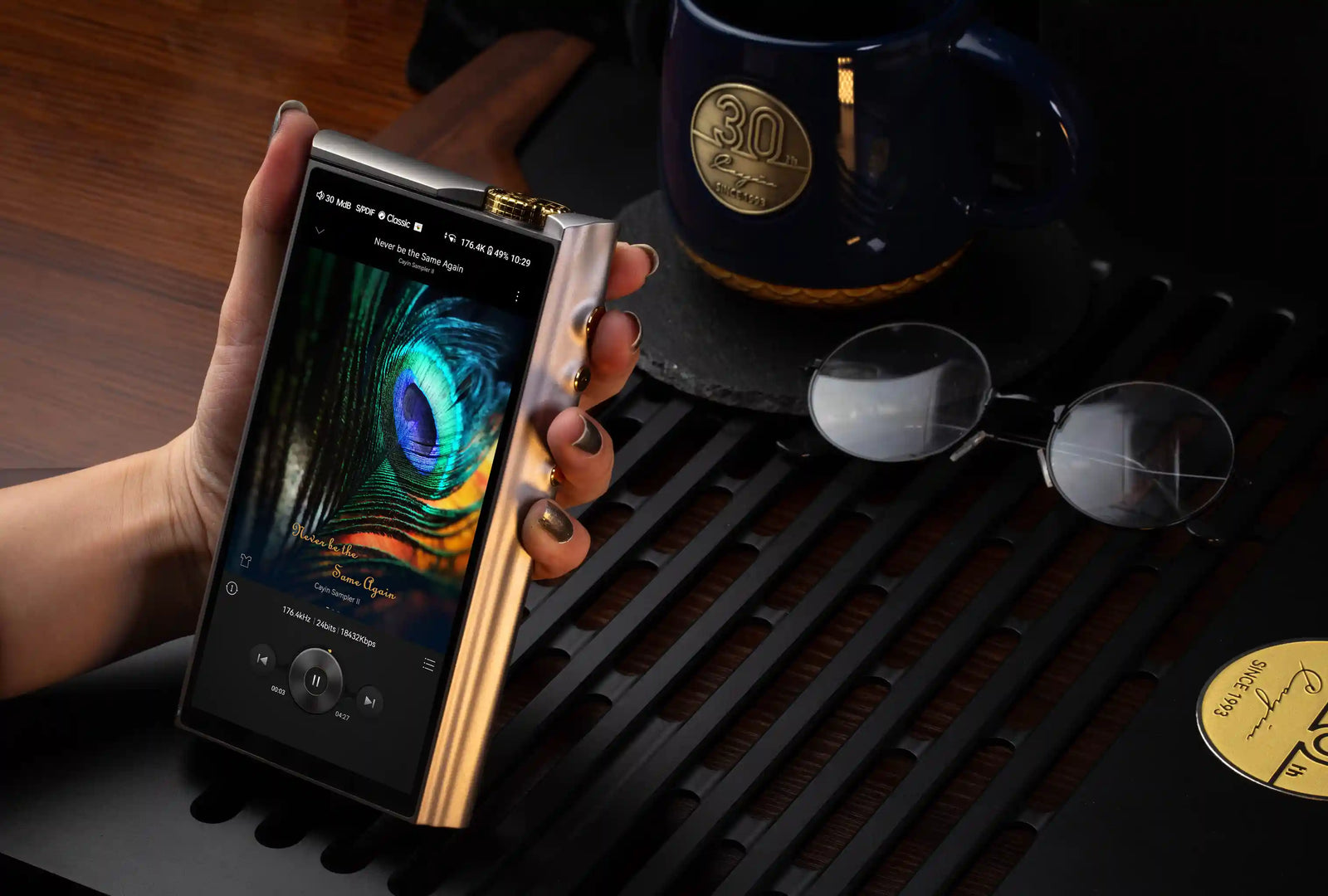
Introduction of N30LE:
As the 30th Anniversary Model, N30LE has a lot of design elements and innovation. Below we will try to explain the design in three segments: Sole Features of N30LE, Core design and Hardware configuration, as well as the Structure, Heat Dissipation and Battery Duration.
I. Sole Features of N30LE:
1. Nutube 6P1 third generation tube technology full analog output application:
Tracing down the history, Cayin's N8 was the first product to apply Nutube 6P1 on portable products, self-developed shock-absorbing structure, eliminated the microphone effect, and gained a lot of customers' favor with the warm and thick sound of the tube.
N30LE uses two different hardware circuits to design two different styles of tube Timbre for the Nutube 6P1: Modern and Classic. It means that when the user chose Tube Timbre he can choose Classic mode suitable for vocal or Modern mode for Instrument. Or Classic mode for thick and warm tones, and Modern mode for transparent and dynamic tones. Customers can choose according to their preference.
No matter which mode or which style it were there would be that someone like it someone not. It is something with personal subjective feeling and also something related to the whole system used. As a result this time for N30LE we gave you all possible solutions.
A rough introduction to the design principles:
Tube circuit adopts three-stage amplification. The first stage is composed of Toshiba low-noise JFET buffer amplifier. The second stage is Nutube 6P1 tube line amplifier which provides main voltage gain for the timbre circuit. It is also the core of the timbre circuit which determines the entire timbre style and your listening experience. The third stage is a buffer driver composed of Toshiba's low-noise JFETs, which improves the driving capability of the entire timbre circuit.
Classic Timbre Circuit:
Zero negative feedback without Loop. Each stage works through the local feedback and gains of each different stages determine the total gain. Tube amplifier circuit distortion dominates the circuit and the THD value of total output is higher. Harmonic distortion characteristics and the sound are typical Tube Sound. Cayin's previous N8 and N3Pro take such style of Circuit.
Modern Timbre Circuit:
Negative feedback with Loop. Negative feedback circuit determines the total gain. Because of the introduction of cross-stage loop negative feedback, the THD distortion of the total output is significantly reduced. Harmonic distortion characteristics and Sound is slightly inclined to the modern Solid State circuit style with less Tube flavor. Representatives of previous products with such style are C9 and N8ii.
Analog Outputs of N30LE include PO, LO, and Pre Out. No matter it is Power Amplification Stage or Voltage Amplification Stage they are all independently designed. In the past for former models of Cayin Tube Timbre is only for PO. However this time for N30LE Timbre Selection is available for all analog outputs. You can choose three different styles of Timbres when you are using N30LE which are Nutube Classic, Nutube Modern and Solid-state. You can choose according to your preferences, headphone used or the styles of musics you are listening to.
2. Hyper Mode Ultimate Performance, Class A and Class AB Amplifier Mode and P and P+ Output Mode:
Regarding portable audio products in the design there are a variety of limitation like Size, Heat Dissipation and Battery Duration etc. However when we are taking Sound Quality as our first priority and relatively ignoring the heat dissipation, battery duration limitation here we are providing you the N30LE with Ultimate Performance, which is the starting point of the Hyper mode.
N30LE's Power Amplification Stage takes Discrete components design and Dual operation modes of Class A and AB are available. Depending on operation voltage there are dual output models of P and P+. Unlike previous models as for N30LE these four modes can be arbitrarily combined whether Balanced or Single-ended output and you can choose to operate Class A and P+ modes at the same time.
Hyper Mode is combing Class A, P+, and numerous operation adjustments to deliver ultimate performance. It is different from a simple combination of above different modes. Hyper Mode is to raise the static operating current and operating voltage of Class A so that it can reach the ultimate performance of N30LE. In Hyper Mode the sound is more pure and transparent, better sound stage with full dynamic. Using Hyper Mode it will generate more heat and the battery duration will be shorter. As a result if you are using Hyper Mode please use it in a well-ventilated and cooled environment if possible.
How to enable Hyper Mode? You can switch it on as in the UI as below:
Hyper
On
0 Wired headphon...
Astrognosia: Aquarius - Vannman...
Norwegian Radio Orchestra
00:26 I◄ II ►I X 01:25
In Hyper mode Class A or Class AB and P or P+ are no longer Selectable. Tube Timbre or Solid State Timbre can still be selected. As a result from battery duration view without taking into account other variables (such as switching the screen on and off, playing music files in different formats, WIFI etc.) the longest and shortest duration of battery are as below:
Single-ended output, Class AB, P mode, Solid State: longest duration approx. 11.5 Hours Balanced output, Hyper mode, Tube: shortest duration approx. 7.5 Hours
II. Core design and hardware configuration of N30LE:
- DAC Chip: AK4499EQ + AK4499EQ, MONO Operation Mode, Full-channel (8 channels) Parallel Fully Balanced Differential Current Outputs
AKM's flagship DAC chip AK4499EQ has been unexpectedly discontinued. Cayin's plan to develop new products using this chip were put on hold due to supply problems. However it didn't stop us from studying the chip's circuitry until we decided to use it for N30LE. As for AK4499EQ we only have limited stocks. It is completely insufficient to support a regular product market size. However if for a Limited Edition of Anniversary Model the quantities we have are more than enough including the ones we spared for future service. AK4499EQ is also perfect for our product orientation of the N30LE.
N30LE uses two DAC chips in mono mode. Regardless of the user to choose Single-ended or Balanced it always works in full-channel.Benefits of such design is that it has the complete sound information and high density. Going through the amplification circuit you can feel all kinds of rich
sound and details. Disadvantages is the heat generated, power consumption and battery duration.
2. Power Supply System Design and Construction:
In order to achieve the full-scene functionality and high performance requirements the Power Supply Design of N30LE is the key and most important part in development of N30LE. The power subsystem is composed of multiple power supplies with complex structure and excellent performance. Each works with its own role under system control to meet the load and power requirements of each scene.
- Main Power Supply: Murata 470mF/5.5V Supercapacitor (EDLC), DMF 12570mAh ultra-large capacity polymer 3.8V lithium battery.
It is the first time that Cayin uses EDLC on Portable products. FARA Class Supercapacitors have extremely low ESR (equivalent series resistance) and extremely fast charge/discharge response characteristics. As the main power supply filter capacitor EDLC and the 12570mAh 3.8V lithium-ion polymer batteries form the power supply center of N30LE to meet the dynamic performance requirements of power supply for all kinds of music.
Lithium-ion polymer battery pack adopts a series of two parallel structure. It requires us to measure and match the capacity and internal resistance first and then use in Parallel. Main power supply structure is the basis of N30LE's excellent Dynamic performance and abundant constant load stabilization output.
B. Amplification Circuit Power Supply:
N30LE has four independent Headphone Amplification Circuit powered by four LT8334 (Linear products) high-current dynamic voltage regulator. We have given up the second level of voltage regulation by linear regulator IC. Instead we have used LC enhanced filter circuit to achieve the second level of filtering and supply directly to the Headphone Amplification circuit. It can make the Power Supply as clean as possible. It can also make the internal resistance lower to achieve faster response.
C. DAC Circuit Power Supply:
Two AK4499EQ DAC chips use two completely independent power supply systems. The left and right channel DACs use completely independent power supply and each DAC power supply includes one TPS61087 Step-up circuit, two LP5907 series LDO circuits, and one TPS7A2050 LDO circuit. More important is that each AK4499EQ VREFH power supply use one LT3045 ultra-low noise, dynamic LDO regulator circuit to supply power to AK4499EQ With independent RC filter circuit. 24 Panasonic POSCAP high-capacity capacitors have been used to make the performance of AK4499EQ to its greatest potential.
D. FPGA and Clock System Power Supply:
FPGA is powered by three LP5907 low-noise LDOs individually supplying 3.3V, 1.8V and 1.2V. Dual femtosecond crystal clock circuitry is powered by one independent low-noise LDO regulators supplying 1.8V operating voltage.
E. Filter capacitors of each sub-power supply use Panasonic POSCAP tantalum polymer capacitors. Together with NP0 and X7R high-quality capacitors it can comprehensively improve the dynamic performance of the power supply system.
- Volume Chip IC MUSES72320V+MUSES72320V from JRC form a fully balanced four-channel hardware volume and gain control circuit. Audio signal circuit of N30LE is fully balanced transmission and amplification.
MUSES72320V has been used on Cayin's C9 and HA-300MKii, which has the ability of linear volume and gain control with high precision, very low distortion and very low noise. However of course, the size, cost, and power consumption etc has limited its space of use. On N30LE we have used two such ICs to realize precise volume control.
- Discrete Headphone Amplification Architecture and Differential Input Stage: Ultra-low noise audio special twin structure junction field effect tube (JFET) 2SK2145 from Toshiba. Voltage Amplification and Power Driver stage: FET from Nexperia.
N30LE headphone amplification circuit consists of discrete components to form a four-channel balanced structure. Differential input stage tubes need to be tested and matched more precisely on basis of the original pairing . We use transistor characteristic curve iconometer to test the twin JFET and then carry out precision testing and pairing. Only performance consistency reaches 99% we will use them in N30LE.
Voltage amplification stage and power driver output stage use Nexperia paired packaged transistors with good thermal stability, superior audio performance and load driving ability. Headphone amplifier circuit can work in Class A/Class AB, P/P+ and three voltage gain (high, medium, low) and other operating modes. Slide down the screen and you will see the menu. Just click and choose the operation mode you prefer.
5. Main Control Unit, Operation System and Display:
Qualcomm Snapdragon 665 as the main control, Android 12.0, 8G+256G storage configuration, HiBy OS system.
Display specifications: 5.99 inches, InCell 18:9 Full HD 1080x2160.
Corning Gorilla Rear Plate. Gesture operation and double-tap to wake up and other operations etc supported.
II. Structure and Heat Dissipation of N30LE
N30LE Case is made of Titanium Alloy, model of which is TC21. As for this kind of material it has high strength hardness, oxidation resistance and corrosion resistance, etc. At the same time the weight of Titanium is lighter than Copper or Steel at the same size. As a result as Cayin’s largest battery capacity and largest size of portable DAP the net weight of N30LE goes to 650 g.
The advantages of titanium alloy are obvious, but the disadvantages are also obvious, that is, its thermal conductivity is much lower than aluminum, copper and even lower than stainless steel. For DAP products heat dissipation has always been a key point in the design. As for N30LE due to the circuit configuration there are a lot of spot where can generate heat. The main source of heat is the two DAC chips, eight-channel IV conversion circuit and four-channel discrete high-power headphone amplification circuit. In order to get the maximum heat dissipation N30LE’s chassis is made out of a block of titanium alloy and CNC machined. Rear panel and chassis are a complete part. In such way it can greatly increase the effective area for heat dissipation. The main frame is also CNC machined out of one piece and we only do an effective physical division for the the tube part, display, battery and PCBA etc. In N30LE there are three graphene heat-conducting sheets and Four pieces of heat-conducting silicone sheet which will transfer heat to the main frame after heat absorption and then do heat dissipation thought the main body.
Specifications
|
Product Information |
|||
|
MCU |
Snapdragon 665 |
DAC |
AKM AK4499EQ x2 |
|
System |
Customized Android 12 |
Volume Control |
MUSES72320V x2 |
|
Memory |
8GB LPDDR4 |
Vacuum Tube |
KORG Nutube 6P1 x2 |
|
Storage |
256GB uMCP, TF x1 (up to 1TB) |
Triple Timbre |
Vacuum Tube (Classic, Modern) Solid State |
|
Battery |
3.8V 12570mAh (48Wh) |
DAO |
Class A, Class AB |
|
Google Play |
Preinstalled |
Dual Output |
P (STD), P+ (High Output) |
|
Lossless |
DTA bypass Android SRC |
Special Output |
Hyper Mode |
|
Display |
6" (2160 x 1080) lnCell multi-point touch screen |
Phone Out |
3.5mm (Single-Ended, dedicated) 4.4mm (Balanced, dedicated) |
|
Physical Control |
Volume knob, Power On/Off Playback control buttons |
Line Out |
3.5mm (Single-Ended, shared) 4.4mm (Balanced, shared) |
|
USB |
Type C: USB3.1, OTG, PD2.0, Digital Audio |
Pre Out |
3.5mm (Single-Ended, shared) 4.4mm (Balanced, shared) |
|
Wi-Fi |
2.4G/5G IEEE 802.11 a/b/g/n/ac |
Digital Interface |
I'S (HDMI-C), USB Audio (in/out) SPDIF Coaxial (embedded) |
|
Chassis |
Sandblasted PVC coated CNC TC21 Titanium |
Bluetooth |
BTv5.0 with multiple codecs LDAC,UAT,AAC,SBC |
|
Dimension |
156 x 89 x 25 (mm) |
Bundled Player |
Cayin Music; HiByMusic (HiByCast supported) |
|
Net Weight |
~650g |
||
|
3.5mm |
Single-ended |
Headphone |
Output |
||||||
|
|
Solid State |
Vacuum Tube |
|||||||
|
Power Rating |
|
160 |
320 |
1500 |
160 |
320 |
1500 |
||
|
p |
420mW |
240mW |
64mW |
420mW |
240mW |
64mW |
|||
|
P+ |
722mW |
480mW |
100mW |
722mW |
480mW |
100mW |
|||
|
Hyper |
722mW |
480mW |
100mW |
722mW |
480mW |
100mW |
|||
|
Frequency Response (Fs=192kHz) |
20Hz-20kHz |
±0.1dB |
±0.6dB (Classic) |
||||||
|
±0.2dB (Modern) |
|||||||||
|
5Hz-50kHz |
±0.5dB |
±1dB (Classic) |
|||||||
|
±0.2dB Modern) |
|||||||||
|
THD+N * (1kHz, Fs=192kHz; 320, A-wgt.) |
0.0008% |
:54.50% (Classic) :50.60% (Modern) |
|||||||
|
Dynamic range* (1kHz, Fs=192kHz; 320, A-wgt.) |
119dB (P+) |
96dB (Classic) |
|||||||
|
109dB (Modern) |
|||||||||
|
SNR* (Fs=192kHz; 320, A-wgt.) |
120dB (P+) |
96dB (Classic) |
|||||||
|
109dB (Modern) |
|||||||||
|
Noise level * (Fs=192kHz; 320, A-wgt.) |
4.0uV (P+) |
7.0uV (Classic) |
|||||||
|
3.5uV (Modern) |
|||||||||
|
Channel separation (1kHz, 320) |
77dB |
67dB (Classic) |
|||||||
|
77dB (Modern) |
|||||||||
|
Output impedance |
0.60 |
||||||||
|
4.4mm Balanced Headphone Output |
|||||||
|
|
Solid State |
Vacuum Tube |
|||||
|
Power Rating |
|
160 |
320 |
1500 |
160 |
320 |
1500 |
|
p |
765mW |
480mW |
150mW |
765mW |
480mW |
150mW |
|
|
P+ |
1210mW |
780mW |
240mW |
1210mW |
780mW |
240mW |
|
|
Hyper |
1210mW |
780mW |
240mW |
1210mW |
780mW |
240mW |
|
|
Frequency Response (Fs=192kHz) |
20Hz-20kHz |
±0.1dB |
±0.6dB (Classic) |
||||
|
±0.2dB (Modern) |
|||||||
|
5Hz-50kHz |
±0.5dB |
|
|||||
|
±1dB (Classic) ±0.2dB Modern) |
|||||||
|
THD+N * (1kHz, Fs=192kHz; 320, A-wgt.) |
0.0005% |
:54.50% (Classic) :50.50% (Modern) |
|||||
|
Dynamic range* (1kHz, Fs=192kHz; 320, A-wgt.) |
122dB (P+) |
102dB (Classic) |
|||||
|
115dB (Modern) |
|||||||
|
SNR * (Fs=192kHz; 320, A-wgt.) |
123dB (P+) |
102dB (Classic) |
|||||
|
115dB (Modern) |
|||||||
|
Noise level * (Fs=192kHz; 320, A-wgt.) |
4.3uV (P+) |
7.0uV (Classic) |
|||||
|
4.5uV (Modern) |
|||||||
|
Channel separation (1kHz, 320) |
110dB |
96dB (Classic) |
|||||
|
110dB (Modern) |
|||||||
|
Output impedance |
1.20 |
||||||
THD+N, Dynamic range, SNR and Noise Level are measured at P+ mode, Class AB, High Gain.
|
|
Solid State |
Vacuum Tube |
|
|
Output Level (10kO) (Adjustable) |
3.2V (High Gain) (max) 1.6V (Mid Gain) (max) 0.8V Low Gain max |
||
|
Frequency Response (Fs=192kHz) |
20Hz-20kHz |
±0.1dB |
±0.6dB (Classic) ±0.2dB (Modern) |
|
5Hz-50kHz |
±0.5dB |
±1dB (Classic) ±0.2dB Modern) |
|
|
THD+N (1kHz, Fs=192kHz; 10kO, A-wgt.) |
0.0008% (High Gain) |
S4.50% (Classic) s0.60% (Modern) 96dB Classic 108dB Modern 97dB Classic 110dB Modern 45uV Classic 11uV Modern 69dB Classic 79dB Modern |
|
|
Dynamic range (1kHz, Fs=192kHz; 10kO, A-wgt.) |
119dB (High Gain) |
||
|
SNR (Fs=192kHz; 10kO, A-wgt.) |
120dB (High Gain) |
||
|
Noise level (Fs=192kHz; 10kO, A-wgt.) |
3.1uV(High Gain) |
||
|
Channel separation (1kHz, 10kO) |
1 00dB |
||
|
Output impedance |
1000 |
||
|
Connector : Mini HDMI (HDMI Type-C) 12S Transmits 12S via HDMI connector, incom atible with standard HDMI devices |
|
|
|
PCM up to 32Bit/768kHz; DSD up to DSD512 |
|
S/PDIF Coaxial |
Connector: USB-C(75O), Embedded |
|
PCM up to 24Bit/192kHz; DSD up to Dop64 |
|
|
USB Audio Out |
Connector : USB-C |
|
PCM up to 24Bit/768kHz#; DSD up to DSD512 (Native) or DoP256 |
|
|
USB Audio DAC |
Connector : USB-C, Asynchronous USB Audio Class 2.0 |
|
Systems: Windows 10, 11 (drivers provided), MacOS, Android(partial), iOS |
|
|
PCM up to 32Bit/768kHz#; DSD up to DSD512 (Native) or DoP256 |
|
|
Bluetooth |
v5.0 |
|
Transmit and Receive Codec: UAT u to 192kHz , LDAC u to 96kHz , AAC and SBC u to 48kHz |
|
# PCM not support 64kHz sampling
|
N30LE Music Format |
||||
|
Format |
Bit-Rate |
Sampling Freq. |
Remark |
|
|
DSD |
DSF |
1bit |
2.8MHz - 22.6MHz |
Native and DoP 02P (convert to PCM 88.2kHz), Supports DST encoded OFF and SACO-ISO |
|
OFF |
1bit |
2.8MHz - 22.6MHz |
||
|
SACO-ISO |
1bit |
2.8MHz |
||
|
PCM |
WAV |
16bit - 32bit |
32kHz - 768kHz |
Supports DTS encoded WAV Supports CUE and LRC 64kHz Sampling not supported |
|
AIF/AIFF |
16bit - 32bit |
32kHz - 768kHz |
||
|
FLAC |
16bit - 24bit |
32kHz - 192kHz |
||
|
M4A (ALAC) |
16bit - 24bit |
32kHz - 192kHz |
||
|
APE (Fast) |
16bit - 24bit |
32kHz - 768kHz |
||
|
APE (Normal) |
16bit - 24bit |
32kHz - 768kHz |
||
|
APE (High) |
16bit - 24bit |
32kHz - 768kHz |
||
|
APE (Ex. High) |
16bit - 24bit |
32kHz - 192kHz |
||
|
APE (Insane) |
16bit - 24bit |
32kHz - 192kHz |
||
|
WMA Lossless |
16bit - 24bit |
32kHz - 96kHz |
||
|
WMA |
16bit - 24bit |
32kHz - 96kHz |
||
|
MP3 |
8bit - 16bit |
32kHz - 48kHz |
||
|
AAC |
8bit - 16bit |
32kHz - 48kHz |
||
|
OGG |
8bit - 16bit |
32kHz - 48kHz |
||








